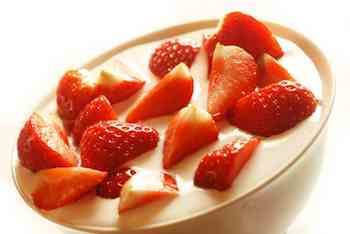- MENU
- HOME
- SEARCH
- WORLD
- MAIN
- AFRICA
- ASIA
- BALKANS
- EUROPE
- LATIN AMERICA
- MIDDLE EAST
- United Kingdom
- United States
- Argentina
- Australia
- Austria
- Benelux
- Brazil
- Canada
- China
- France
- Germany
- Greece
- Hungary
- India
- Indonesia
- Ireland
- Israel
- Italy
- Japan
- Korea
- Mexico
- New Zealand
- Pakistan
- Philippines
- Poland
- Russia
- South Africa
- Spain
- Taiwan
- Turkey
- USA
- BUSINESS
- WEALTH
- STOCKS
- TECH
- HEALTH
- LIFESTYLE
- ENTERTAINMENT
- SPORTS
- RSS
- iHaveNet.com: Health
Victoria Shanta Retelny, R.D.

Digestive health is a big priority these days -- the U.S. probiotic ("friendly bacteria") market is projected to be worth up to
In the early 19th century, when the concept of probiotics and their proposed colonic health benefits first emerged, fermented milks were the only known source of these beneficial microorganisms. Today, probiotic products have exploded onto the U.S. "functional food" scene. You can find live, active cultures in fermented dairy products like yogurt and kefir, as well as in miso, tempeh (fermented soybeans), and some infant formulas, juices, soy beverages, granolas, chocolate bars, cereals and dietary supplements (in capsule, tablet and/or powder forms).
PROBIOTICS UNDER THE MICROSCOPE
Inside each of us, at the tiniest microscopic level, there are unique colonies of about 100 trillion bacteria that live in constant, ever-changing interaction. Although some bacteria are destructive and cause disease and ill-health, there's a whole army of "do-gooder" bacteria that is safe for the human body, and offers a whole spectrum of gastrointestinal health benefits. These range from promoting gut and intestinal functions to developing a healthy immune system. The key is cultivating the good bugs and getting rid of the bad ones.
We've only touched the tip of the human microbial iceberg. According to Mary Ellen Sanders, Ph.D., a probiotic microbiology consultant, "Eighty to 90 percent of colonic bacteria have never been cultured; it's only through new DNA-based techniques that we are just beginning to have a more complete picture of what microbes are there."
Although there's no legal definition for probiotics, the widely accepted scientific definition established by the
According to probiotic literature, the most widely used probiotic strains (or varieties) in U.S. food products are from the Lactobacillus or Bifidobacterium species, as well as the yeast Saccharomyces cerevisiae (boulardii), and a yogurt starter culture, S. thermophilis. Strains of Enterococcus, Bacillus and Escherichia are used primarily in supplement form.
PROBIOTICS ON THE MARKET
The biggest probiotic category of foods in the U.S. is fermented dairy products, such as yogurt, kefir and cheeses, according to an article co-coauthored by Sanders in the
Since there are so many probiotic products making health claims these days, consumers should keep in mind three simple guidelines, according to the probiotic authority website, USProbiotics.org, about microbes in probiotic products:
1. They must be alive when consumed.
2. They should be documented to have a health benefit.
3. They must be given at levels to result in a health benefit.
Along with that, consumers should keep in mind that the types and amounts of live, active cultures vary among products.
"Different strains do different things. Probiotics are strain- and dose-dependent; you can't assume that they all do the same thing in the same amounts," Sanders advises. Foods and supplements contain different genera, species and even strains of the same species, so scientific testing is important when it comes to the effects of probiotics. Sanders cautions that not all microbes sold as probiotics have been clinically tested on humans for health effects; thus, consumers should look for probiotic products with claims that are substantiated by published, peer-reviewed, clinical human trials. Consumers can dig deeper by contacting the company directly or looking at its website.
PREBIOTICS FEED GOOD BUGS
Although probiotics and prebiotics (which interact with other, "good" bacteria) have different jobs in the body, they are believed to work well together in a "symbiotic" relationship, which is harmony at its best. Good bacteria thrive with the right food--and that's where prebiotics come in: They're defined as "non-digestible food ingredients that beneficially affect the host by selectively stimulating the growth and/or activity of one or a number of bacteria already in people's colon," by the
The main source of prebiotic sugars in the U.S. food supply is from fructo-oligosaccharides (FOS). FOS is found naturally in many foods like onions, bananas, honey, wheat, artichokes, garlic and leeks. It can also be isolated from chicory root or made with enzymes from table sugar. When fermented in the colon, prebiotic sugars like FOS are believed to offer a spiral of benefits to the body, such as increasing the number of the probiotic bifidobacteria in the colon, increasing calcium absorption, lessening the length of time food stays in the gastrointestinal tract and possibly lowering blood lipid levels.
Prebiotic supplements--whether sprinkled on food, stirred into beverages, or taken as a capsule, tablets or chewables--may provide an easy, foolproof way to boost prebiotic fiber consumption, advises Sanders.
The expert consensus is that more long-term studies on the effects of healthy bugs are needed.
"It's difficult to do research to show healthy people getting healthier," says Sanders of the probiotic research field. For now there doesn't seem to be much of a downside from adding probiotics and prebiotics to your diet.
Available at Amazon.com:
The Paleo Diet: Lose Weight and Get Healthy by Eating the Food You Were Designed to Eat
The Paleo Diet for Athletes: A Nutritional Formula for Peak Athletic Performance
© Environmental Nutrition Newsletter
AGING | ALTERNATIVE | AILMENTS | DRUGS | FITNESS | GENETICS | CHILDREN'S | MEN'S | WOMEN'S
Health - Inside the World of Friendly Probiotics